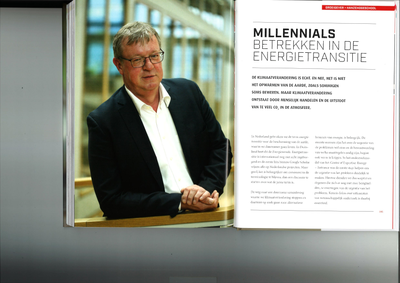This chapter explores how various organizations are engaging millennials inthe energy transition. In the climate accord from Paris, almost all countriesin the world agreed upon reducing greenhouse gasses, so climate change willbe limited. In order to do so, we do need to cut down on our use of fossil fuelsand we do need to alter our behaviour. In this chapter, we study how organizations are engaging with young people, often referred to as millennials onthis subject. Millennials are seen as digital natives, and they grew up withdigital communication. Do organizations engage millennials in this energytransition and engage them in a way that millennials do communicate? Ourstudy showed that, with a few exceptions, organizations do not use interactivemedia and elements that millennials use, and in this, do not engage millennials to join in the energy transition. We give some suggestions on how organizations can engage millennials to a larger extent
DOCUMENT
Creative tourism has recently emerged as an important area of tourism development, particularly in the Global North. In the Global South, studies of the profile of creative tourists and their motives for partaking in creative tourism are limited. This paper investigates creative tourism demand among South African millennials, analysing what motivates their participation and developing a descriptive consumer profile. CHAID analysis was used for segmentation, revealing a group with a high participation intention and a second group with a low probability of creative tourism participation. Creative tourism intentions were linked to knowledge acquisition, skills and escape motivations, and demographic characteristics including relationship status and gender. Respondents were more likely to participate in domestic rather than international creative tourism, indicating the potential for creative tourism development in South Africa. The findings could help managers and policymakers meet the needs of creative tourists, addressing shortfalls in product development, experience design and marketing.
LINK
Nee, niet alles zit jullie mee beste millennials, maar met voorgaande generaties verwijten meer geluk te hebben gehad schieten jullie niks op.
MULTIFILE
DOCUMENT
As a teacher in ICT and Media Design at Fontys University of Applied Sciences I know but all too well what many of my students want. They are part of a makers community. Most of them just want to build cool stuff with whatever (new) technology may be relevant. My students are by grosso modo millennials or even post-millennials: a synthetic generation for whom the concept of digital ‘transformation’ is alien (van Doorn, Duivestein, & Pepping, 2019). So most of my students are digitals natives: they use ICT as a tool to make a positive impact on society. But does that mean they use their (ICT) skills to build the right things? Or more specifically: do they automatically build things in a right manner? I don’t think so and I will be happy to explain my reflective thoughts about this later on in this essay. But let me give you an example from my daily practice first.
DOCUMENT
Hoofdstuk in het boek "Communicatieverhaal halen"
MULTIFILE

This article offers an overview of 94 scientific studies (published between 2006 and 2022) to examine how young people (ages 10–36) define, consume, and evaluate news. Research on news and youth has exploded over the past decades, but what can we conclude from it, and how should journalism scholars move forward? The systematic literature review reveals that while young people remain interested in news, how they consume it has changed drastically. Social media platforms and algorithms now play a pivotal role in young people’s news consumption. Moreover, due to the overwhelming nature of today’s high-choice digital media landscape, youth engage both actively and passively with news, while sometimes exhibiting avoidance tendencies. The review also demonstrates how the impact of digitalization has reshaped young people’s ability to critically evaluate the credibility of news, often relying on social networks and technology platforms. The review concludes with a research agenda.
MULTIFILE

DOCUMENT
DOCUMENT
DOCUMENT